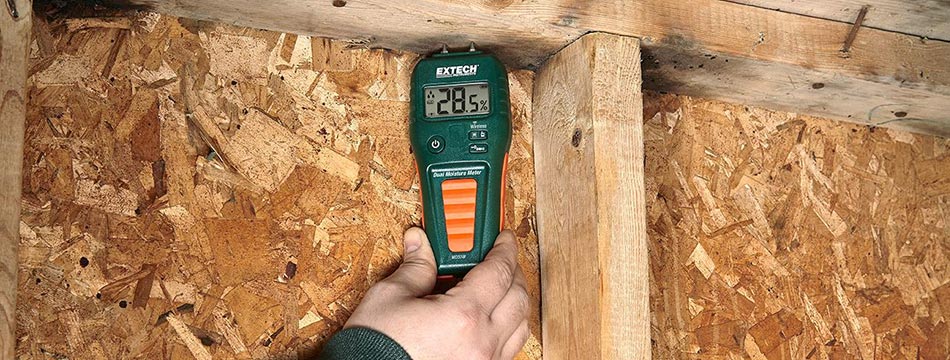
As we venture into the damp and unpredictable autumn-winter season here in the UK, moisture management in construction becomes all the more crucial. For construction professionals, the ability to identify and manage moisture and dampness issues is paramount. These silent adversaries can undermine structural integrity, lead to mould infestations, and result in costly post-construction repairs. In this article, we look at the essential aspects of moisture detection, focusing on why it's critical, defining acceptable moisture levels, methods for detecting moisture in walls and floors, and strategies for effectively rectifying these issues.
Quick Links
- The Significance of Moisture Detection
- Determining Acceptable Moisture Levels
- Detecting Moisture in Walls and Floors
- Addressing Moisture Issues
- Moisture Meters and thermal imaging
- Further Information
The Significance of Moisture Detection
Moisture-related challenges in construction are not mere inconveniences; they are formidable threats to project success. The stakes are high, and here's why moisture detection is an indispensable skill for construction professionals:
Preserving Structural Integrity: Moisture infiltration can weaken wooden structures, culminating in structural failures, which are especially concerning for load-bearing elements like beams and joists.
Mould and Fungi Management: Damp conditions create a breeding ground for mould and fungi, which can be detrimental to both the integrity of the wood and the health of occupants.
Cost Mitigation: Addressing moisture-induced damage post-construction is both costly and time-consuming. Detecting and mitigating moisture issues during the construction phase is not only economically prudent but also ensures project longevity.
Determining Acceptable Moisture Levels
Understanding what constitutes acceptable moisture levels in construction materials is essential. Generally, for wood used in construction, the optimal moisture content hovers around 12-15%. Moisture levels exceeding 20% should raise red flags.
Acceptable levels will depend on whether the wood is for woodwork and interior use or external work. Moisture levels will also vary depending on location and Relative Humidity (RH) in the area.
Detecting Moisture in Walls and Floors
Moisture Meters: Employ the use of precision moisture meters, such as pin-type or pinless meters. These sophisticated devices offer real-time moisture content measurements, delivering precision and reliability. By inserting pins or placing the meter against the surface, you can instantly gauge moisture levels with precision.
Visual Inspections: Perform visual inspections for evident signs of moisture, including stains, discolouration, or signs of paint or wallpaper deterioration. These are common indicators of moisture issues.
Musty Odor: Trust your senses. The presence of a musty odour can signify hidden moisture problems.
Exterior Assessment: Investigate the building's exterior for any signs of water infiltration, such as foundation cracks, roofing issues, or blocked gutters.
Addressing Moisture Issues
Once moisture issues are identified, prompt and effective action is crucial:
Leak Resolution: If the source of moisture is located, rectify it immediately. This could involve fixing leaky pipes or repairing the roof.
Ventilation Management: Implement proper ventilation strategies in moisture-prone areas, such as bathrooms and kitchens.
Dehumidification: Utilize dehumidifiers to extract excess moisture from enclosed spaces, ensuring the maintenance of ideal moisture levels.
Wood Preservation: For salvageable wood, consider treatment with wood preservatives to prevent further moisture damage.
Reconstruction: In severe cases where structural integrity is compromised, consult with experts and prepare for necessary repairs or replacement.
In conclusion, for construction professionals, the mastery of moisture detection is not just a skill but a responsibility. The utilisation of moisture meters, knowledge of acceptable moisture levels, and the ability to detect and address moisture issues are the cornerstones of a successful and enduring construction project. By preserving the structural soundness of the buildings you create, you exemplify professional excellence and ensure the safety and satisfaction of your clients.
Moisture Meters and Thermal Imaging
To equip yourself with the finest tools for moisture detection and ensure the success of your construction projects, look no further than PASS Ltd. We offer a comprehensive range of Extech moisture meters and cutting-edge Flir thermal imaging cameras, meticulously designed to bolster your moisture management efforts and provide unrivalled precision.
Further Information
Don't leave the integrity of your structures to chance. Get in touch with PASS Ltd today to discuss moisture meters, thermal imaging cameras and other test and measurement solutions to help you with your construction work.
Please don’t hesitate to contact us on 01642 931 329 or via our online form.
In the meantime, please browse our complete range of moisture meters and thermal cameras.


